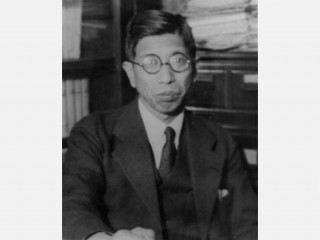
Masuzo Shikata biography
Date of birth : 1895-08-10
Date of death : 1964-05-08
Birthplace : Tokyo, Japan
Nationality : Japanese
Category : Science and Technology
Last modified : 2010-06-01
Credited as : Electrochemist, the first polarograph ,
0 votes so far
Masuzo Shikata was born in Tokyo, Japan, on 10th August 1895.
He spent his boyhood days in Mito near Tokyo. Masuzo Shikata was educated in Tokyo and graduated from the Department of Agricultural Chemistry of the Imperial University of Tokyo in 1920. Already at that time he was interested in organic electrochemistry. After graduation from the University, Masuzo Shikata studied electrochemical oxidation of benzene to benzoquinone under Professor Umetaro Suzuki at the Research Institute of Physics and Chemistry (Rikagaku Kenkyusho) in Tokyo.
Photo of Masuzo Shikata (left) and J. Heyrovskytaken on December 23, 1923, in London when Shikata and Heyrovskyvisited there for giving papers about polarography.
(The picture of Masuzo Shikata was kindly donated for my web site by Prof. Takashi Kakiuchi)
In 1921 Shikata received scholarship from Ministry of Education, Japan, that allowed him to stay in Germany, where he studied surface chemistry under Professor I. Traube in Technische Hochschule in Berlin. At this time, Professor J. Heyrovskystarted original and fruitful research applying a dropping mercury electrode for electrochemistry. Young Shikata was deeply interested in this work and finally in 1923 he joined the Heyrovsky’s group in Prague.
Under Professor J. Heyrovskyhe studied the electrochemical reduction of nitrobenzene on a dropping mercury electrode. This was the first polarographic study of organic substances (Trans. Faraday Soc. 1925, 21, 24; J. Agric. Chem. Soc. Jpn. 1925, 1, 533). During this study Shikata discovered for the first time the phenomenon of polarographic current maximum and gave it an explanation based on the adsorption and desorption of nitrobenzene at the electrode surface.
The progress of the extension of investigation of the electrolysis with the dropping mercury electrode by J. Heyrovskyand his research group was limited by the fact that the point-by-point measurements and plotting of current-voltage curves was tedious and time consuming. Considerable improvement was achieved in 1924, when the cooperation of J. Heyrovskyand M. Shikata led to construction of an apparatus which registered current-voltage curves automatically.
The new instrument recorded photographically such a curve in several minutes, whereas manual recording took an hour or longer. In their joint paper (J. Heyrovsky, M. Shikata, Rec. Trav. Chim. Pays-Bas, 1925, 44, 496), Heyrovskyand Shikata proposed for the instrument the name “polarograph” and for the studies of electrolysis with the dropping mercury electrode coined the term “polarography”. Development of an automatic method of recording, a short time after the discovery of the new technique, played an important role in the development and dissemination of method based on electrolysis with a dropping mercury electrode.
Currently, most physico-chemical and analytical methods are carried out using automated techniques, but in the early twenties an automated instrument represented very progressive and advanced instrumentation (e.g. recording spectrophotometers became generally accessible only two decades later).
Masuzo Shikata photo probably taken in his office at the Department of Agricultural Chemistry, Kyoto University, just before he left Kyoto for the Manchruia, in 1942.
In 1924 Masuzo Shikata was appointed to Professor of the Imperial University of Kyoto (Kyoto University at present) and he held the chair of Professor of Wood Chemistry in the Department of Agricultural Chemistry. In 1942 Shikata was appointed to the Vice-President of the Research Institute of Science of Manchuria (Tairiku-Kagakuin). He also held a chair in the Chemical Research Institute of Kyoto University since its establishment in 1927.
In Kyoto University Shikata organized good scientific group and carried out many outstanding works not only in polarography but also in the field of wood chemistry and related subjects. As he continued the polarographic study of organic substances, he became especially interested in clarifying the correlation of polarographic reduction potentials of organic compounds with their structures. The “polarographic electronegativity rule” (Collect. Czech. Chem. Commun. 1938, 10, 368) represented the crystallization of the ideas resulting from the extensive studies of organic polarography.
Shikata also made many pioneering works in applying polarography in analysis of biological materials, food and fermentation products. In the field of wood chemistry he extensively studied pulping of woods and grasses of subfrigid and tropical zones. He succeeded in manufacturing superior rayon pulp by sulfite process from Manchurian larch. Shikata first discovered the presence of mannan in certain hardwoods of subfrigid zones. He also studied the utilization of Saghalien tundra and made pioneering work for manufacturing fibre board from tundra, which led him to fundamental studies on the electric disturbance of adsorbed water molecules on fibre by alternative electrical field of high frequency and on physics and chemistry of surface phenomena.
After the World War II Masuzo Shikata took service in People’s Republic of China and returned to his home country only in 1953. In 1954 he was appointed to professor of Nagoya University, from which he retired by age limit in 1959.
Masuzo Shikata was awarded the Royal Grant for his study of Sakhalin tundra. He received the Academic Prize of the Agricultural Society of Japan in 1952 and the Royal Prize of the Japanese Academy of Sciences in 1954 for his outstanding contribution to polarography.
In Nagoya he felt ill and after retirement rested quietly under medical care at his home in Kyoto. Fortunately, he was getting well that he looked almost normal in health.
Professor Masuzo Shikata died a peaceful death by an apoplectic stroke at his home of Yoshida-honmachi 5, Sakyo-ku, Kyoto at 9:20 pm on May 8, 1964. Professor Masuzo Shikata was a man of hard work and deep thinking. He was profoundly interested in everything that happened around him and was always seeking explanations.
















